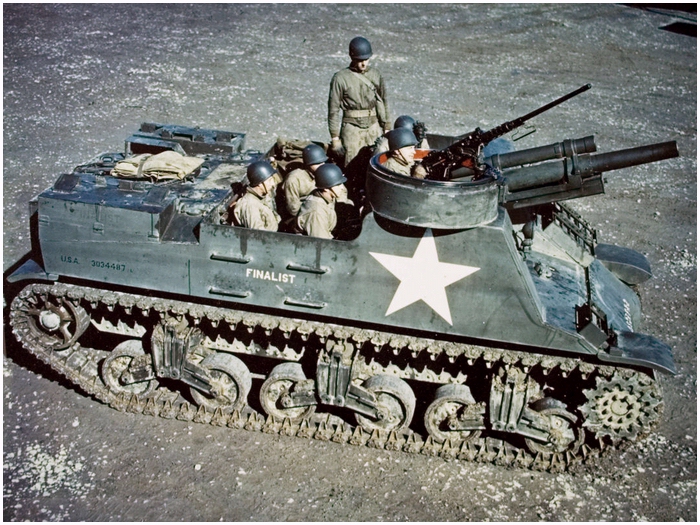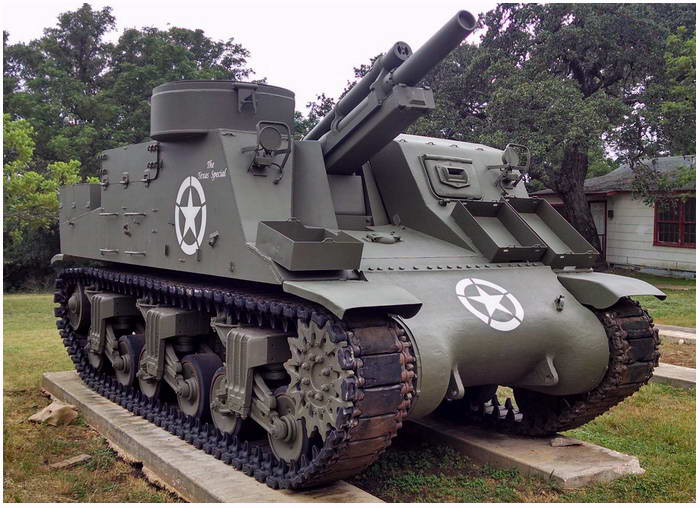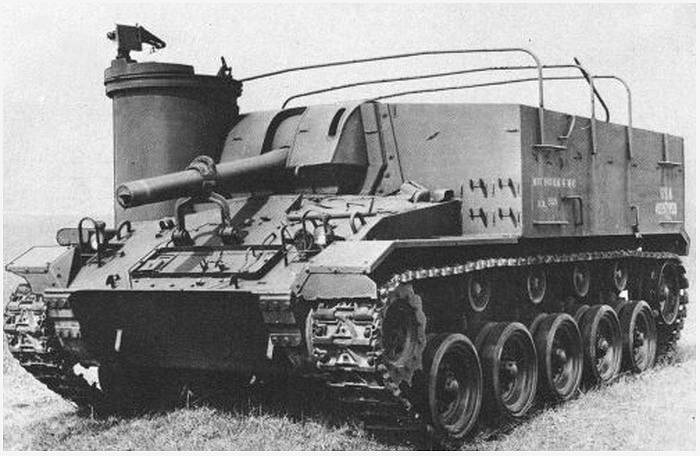
Preface
Many years ago, around the year 2000, I bought an Elbow Telescope in the wreckage museum Musée de Epaves sous-marines
de Débarquement, near Port-en-Bessin.
It was recovered from the sea and had some corrosion and shells on it. I asked in the shop what kind
of 'telescope' this was, but the friendly woman could not give an answer.

The Elbow Telescope M16
Not knowing exactly what I
had bought, I put it on my website and asked my readers about it. I had to wait almost two years before
an answer came from Edwin Herkert and in the same week, Jeff Lewis gave me the same answer. The Elbow Telescope
M16 was from a M2A1 howitzer, which could have being mounted on an M7 'Priest' selfpropelled gun.

The M7 'Priest' in the wreckage museum near
Port-en-Bessin
In September 2003, I went back to the museum near Port-en-Bessin. This time I got
a confirmation it once belonged to the M7 'Priest' that was displayed outside as part of the museum collection.
The development of the
105mm M7 'Priest'

To give support to a fast moving infantry, it was essential to have a selfpropelled
cannon. Experience with a 105mm howitzer on a Half Track led to the development to place a 105mm cannon
on a full tracked vehicle. The M3 and M4 tank chassis (Lee Grant and Sherman tank) was an excellent choice. The gun was placed
somewhat right from the middle in the vehicle. On the right side a distinctive round steel construction
was created to house the .50 machine gun. Two prototypes (T32) were accepted in February 1942 and these
were produced under the designation M7 Howitzer Motor Carriage (HMC). Because of the round turret, the
British called the M7 the 'Priest, after the pulpit in a church.

Een M7, aan land
gekomen op Utah Beach, trekt door Carentan,
Normandië
The cannon, a M1A2 105mm L/22.5 howitzer, was operated by 6 men and 6 in reserve.
Three were needed for loading, directing and firing. The driver and his assistant driver and the
reserve gunner helped with unpacking and uploading the shells. The gunner left of the gun used a
so called panoramic telescope (M12A2) and a Range Quadrant M4 to position the cannon sideways and
in elevation during indirect firing. To give fire in a direct manner, the gunner used on the right
side the Elbow Telescope M16.

The white circle shows the position for
the Elbow Telescope M16
M7
The first M7's that were produced had the M3 chassis. Later models were
given the M4 chassis. The engine was a Continental R-975 C1 radial of 350 hp.
When the M7 was a month into production, the capacity for ammunition was enlarged from 24, to 69 shells.
A total of 3490 M7's were produced.

A British M7 in
Tunesia, 1943
The first time th M7 was put into action, it was with the British army. They had received
,through the Lend-Lease deal with the US, ninety
examples of the M7 in September 1942 and they were deployed during the battle for El Alamein.
The British ordered a total of 5500 M7’s, but this order was never fulfilled.
M7B1
When the chassis of the M4A3 became available for the 'Priest, it was designated as
the M7B1. The engine was in this version was a Ford GAA V-8 (450 hp).

An M7B1 during the Battle of the Bulge, December 1944
On the outside the first difference you may notice to distinguish the two are the tracks.
The M7B1 has extra wheels on the bogies for the top track, and at the front it had a smooth armored
front plate. Both version had a speed of around 40 km/h and the radius was between the 160 and 200 km.
The weight for both models was around the 25 tons.

A preserved M7B1
The M7 and the M7B1 were very successful. Every American armored division had
in 1944 three battalions of this howitzer in their units, which were put into action during the
Battle of the Bulge with great success. A converted M7B1 which had the howitzer under an angle of
+65° (degrees),with the designation M7B2 saw action during the Korean war.
The M7B1 and others variants of the ‘Priest’ could be found in many armies worldwide years
after the Second World War ended. A total of 777 of the M7B1 were produced, (with a total of 4267 ‘Priests’ built).

An Israeli M7B1 during an exercise
Sexton
Despite that the British used the 'Priest' with great success, they would like to see
if one could be up-gunned with their own 25-pounder cannon. The Canadian firm Locomotive Works,
in Montreal managed to built such a gun, a 25-pdr C Mk II, on a chassis of a RAM tank.
This type, called the 'Sexton, went into service during September 1943.

A Sexton of the 13th
Regt. Royal Horse Artillery, 11th Armoured Division
It looked like the M7, but the big difference was the deletion of the round
pulpit for the .50 machinegun, and the driver sat on the right side of the vehicle.
Of the first order for 300 Sextons, 125 were built onto the chassis of the ‘Ram’, and the rest on the
'Grizzly' chassis (a chassis of the M4A1) and were given de designation Sexton Mk I.
A total of 2150 Sextons were
built (of these, 2026 were Sexton Mk II's) before the production came to an end in 1945. It stayed
in British service well into the fifties of the last century.

A preserved Sexton
in Ver-sur-Mer, Normandy.
After July 1944 the M7 'Priest' was replaced by the Sexton within the 21st Army
Group in West Europe. The obsolete 'Priests' of the 2nd Canadian Corps had there howitzers removed and
were rebuilt as 'Kangaroos', the armored personal carrier. Between October 1944 and April 1945, 120 were
converted as such.

A Sexton Mk II with a
M4A1 Sherman chassic as a basis
Direct na de oorlog werden verschillende Sexons verkocht aan
Portugal, welke er tot in de jaren 80 van de vorige eeuw mee
opereerde.
M37
During 1945 the follow up for the M7 was introduced,
the M37. The chassis came from the M24 'Chaffee' tank. The howitzer was a 105mm from a M4A3 Sherman.
Despite it's weight of 'just' 23 tons, there was more room for the crew to work in. The engine was a
Twin Cadillac Series 44, V-8 (220 hp) that gave the vehicle a top speed of 50 km/h and a radius of 160 km.
There were 316 produced, but it never saw action in World War Two.

An M37, built upon the chassis of an M24
RETURN
|